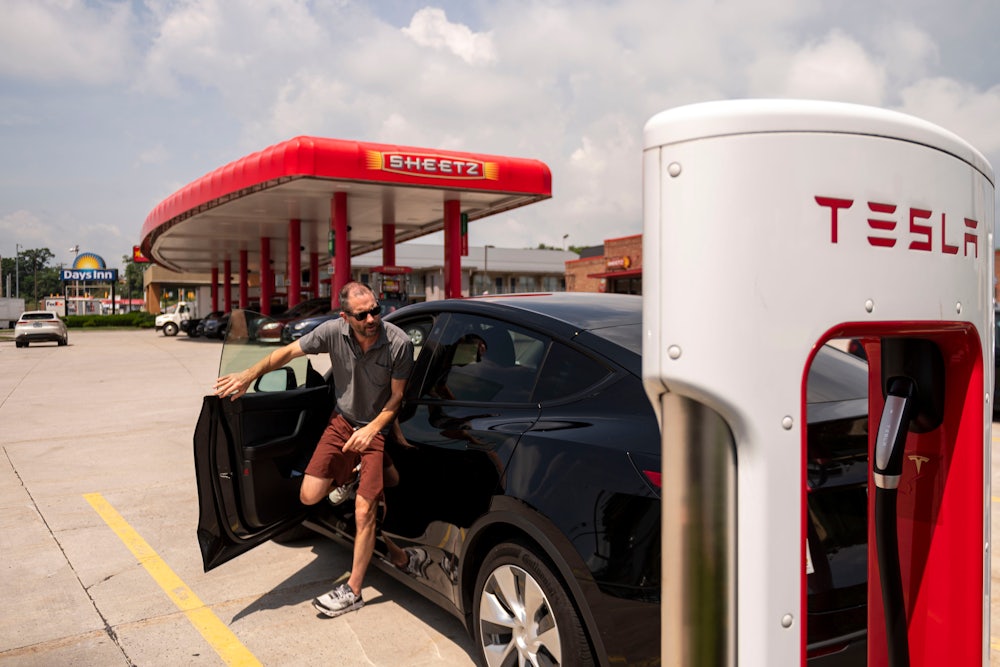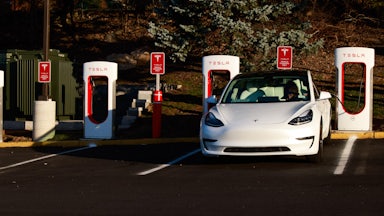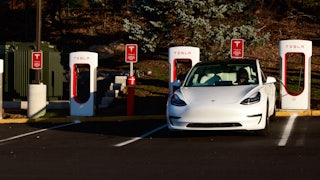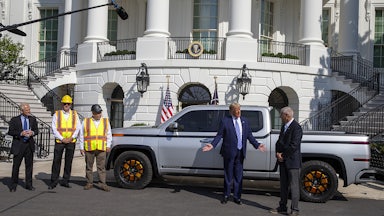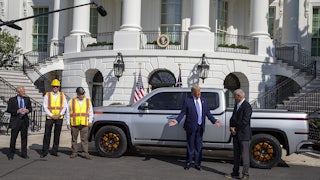Cassandra Berger got her first tattoo two years ago. It wasn’t flowers, or the word “Mom” emblazoned on a heart. Rather, the 29-year-old devoted her first ink to a gas station.
Berger, otherwise known as KT Girl, got the letters “KT” tattooed on her ring finger to show how “committed” she is to the Midwest gas station brand Kwik Trip, which has 800 stores across the Midwest. An influencer for the brand, Berger is reportedly paid in Kwik Trip apparel gas gift cards. The same year she got inked was also the year she became one of the first people to ever visit all of the more than 450 locations Kwik Trip operates in its home state of Wisconsin in a year’s time.
Berger is not alone in her fanaticism. Known for clean bathrooms and brand-specific fast food, American consumers have long displayed obsessive loyalty to regional gas station brands. What these chains may lack in numbers compared to big corporate locations—both Shell and Exxon each have more than 12,000 stations across the United States, dwarfing Kwik Trip’s presence—they more than make up for in cultural cachet.
Kwik Trip fans have gotten married in its aisles. TikTok famous rapper Yung Gravy sports their merch on stage. Like Berger, a fan of the east coast Sheetz gas station chain recently tattooed the company’s logo on their forearm. In Texas and across the American South, Buc-ee’s is known as much more than a gas station: it’s an over-the-top convenience store that serves up walls of beef jerky, a deli counter, ample beaver-branded merchandise, and “inspires loyalty that goes well beyond rational consumer calculations,” according to Texas Monthly. Some people have even spent 24 hours at its locations.
But amongst the cultural fanfare for regional chains, the future of these fuel stops is uncertain. Gas stations have for decades been on the decline in the U.S., falling from around 210,000 locations in 1991 to just 145,000 today; now, many are at an inflection point as they face increased electric vehicle sales and declining gasoline demand. While some stations are trying to electrify, the process is hard and full of red tape—and some chains still have a foot in the past as they continue to advocate for fossil fuel usage while holding onto their cult status.
While big oil companies were once king of the corner market, today the top five largest oil companies own just around 1 percent of gas stations in the U.S. The appeal of the regional chain, which has taken over in regularly providing consumers with gas, is deeply linked to American car culture, where independence is intertwined with the open road. In many parts of the country, a gas station is more than a place to fuel up for an adventure. It’s a gathering place and a grocery store. This is not by chance: in more remote areas, these all-in-one chains can act like a Walmart or a Dollar General, playing a huge role in local economies.
In a promotional video released last year, Kwik Trip Director of Corporate Communications John McHugh said the gas station company has taken the place of many small, local grocers. The company plans to continue its “strongest niche” and become a “replacement for those grocery stores in our small rural communities here in Wisconsin, Minnesota, and Iowa,” he continued.
Just as the corner grocer has changed, so has the country’s fuel source. Most major car companies are shifting significantly to E.V. production: by 2034, GM has said it will no longer sell any gas-powered cars. The Biden administration plans to have at least 50 percent of all vehicles sold to be electric by 2030 and wants to increase the number of public charging stations by the end of the decade as well. The federal government especially wants to invest in charging outside of major cities, with billions of dollars set aside for adding charging to rural areas of the country.
Matthew Metz, the founder of Coltura, a nonprofit trying to get vehicles off of gasoline by 2040, said the types of gas stations that will do well in an electrified country are the ones that follow the model already laid out by the likes of Buc-ee’s and Kwik Trip. A focus on amenities, food, and drawing in customers like moths to a flame will keep consumers on location while their cars charge; cultural loyalty to the brand will incentivize them to return. In this future, the monolithic gas station will become even more of a community hub than it already is.
“In a lot of parts of the country, suburban and otherwise, people are pretty isolated,” Metz told me. “We don’t spend very much time together. We don’t have many places of community. So, the ones that we have, people value.”
There are signs that regional chains are adapting to chargers, albeit with lots of red tape. According to reporting, Buc-ee’s has charging stations in six states; the majority of them are Tesla Superchargers, part of a larger trend of the manufacturer cornering the charging infrastructure market. Sheetz, meanwhile, now offers Tesla charging at 14 percent of its locations; a Sheetz executive told Bloomberg that its locations were “very early adopters of EV charging.” (A Buc-ee’s spokesperson declined to comment on this story, which was a similar response for most of these brands: Kwik Trip, Sheetz, and Casey’s General Store of Iowa did not respond to requests for comment for this story.)
Matt Cowart has been keeping track of this change. A resident of Crossville, Tennessee, and founder of a Buc-ee’s Facebook fan page with almost 3,000 followers (which is, incredibly, on the smaller side compared to some other online fan groups), he’s been documenting the construction and development of these gas stations in his region for a few years. He said the chain has welcomed electric charging stations and is “good for the communities that they open in—especially the smaller communities.”
But these stations are still a crucial peg in the climate crisis. An estimated 80 percent of all gasoline in the country comes from convenience stores, according to the National Association of Convenience Stores. Greenhouse gas emissions caused by the transportation sector make up the largest chunk of the nation’s emissions, and almost all of the fuel used is gasoline.
Some of the owners of regional stations also have a worrying track record of right-wing politics and morality policing, which could impact how they choose to promote E.V.s. The founder of Buc-ee’s came under fire in 2021 for personally donating to Texas Republicans such as Governor Greg Abbott, who signed a law imposing harsh fees on E.V. owners. Meanwhile, Kwik Trip founder Don Zietlow hosted a 2016 campaign dinner for then-candidate Donald Trump in Lacrosse, Wisconsin; in 2020, Zietlow and his wife gave hundreds of thousands of dollars to Republican candidates, including Wisconsin Representative Tom Tiffany, who has criticized E.V.s and other environmental policies. The company also has an unspoken rule about not selling condoms in their stores as they are a “family business.”
Ryan McKinnon, a spokesperson for the E.V. advocacy group Charge Ahead Partnership, said the biggest hurdle for a gas station to expand into E.V. charging is the monopoly that utility companies currently have on the marketplace. Chains have to pay large fees and upfront costs to install charging networks at their locations, while power companies are investing in at-home charging.
Some lobbying groups for convenience store chains are taking power companies to court in hopes to level the playing field for gas stations. In Colorado, utility Xcel Energy recently announced plans to install their own E.V. chargers; a coalition of gas stations and convenience stores said in May that it would sue, claiming the practice would be “anti-competitive” as retail locations are “ideal candidates” for charging stations. Similar proposals from state utilities have cropped up in Oklahoma, Texas, and Georgia and have been met with equal gas station ire.
Regional brands may have large followings, but they are a drop in the bucket when it comes to their global counterparts. Big oil brands like Shell and BP have invested millions in creating E.V. charging at their locations, which could undermine the attempts for regional stations to lead the charge when it comes to E.V.s.
“At this point, there’s not really a sustainable business model for [charging],” McKinnon said.
What’s more, the traditional role of a gas station like Sheetz or Buc-ees just might not fit in the world of E.V. charging. Most E.V. charging happens at home, and while gas stations say they want to capture the E.V. market, the time it takes to buy a snack is far less than what it takes to charge a car. Big box stores like Walmart and other retailers have started to install thousands of chargers around the country, creating competition for consumers who may rather spend the time it takes to charge their car shopping for groceries or clothing rather than hanging out in a convenience store.
With this in mind, regional stations have kept one foot in the fossil fuel business. Early this year, Kwik Trip joined the American Petroleum Institute and Wisconsin’s most influential business lobbying group to advocate for a state bill to prevent the ban of fossil fuel–based vehicles in the state and stop local governments from rolling out zero-emissions mandates.
“Will we still sell fossil fuels tomorrow? I think we’ll sell fossil fuels for a while,” Zietlow, the Kwik Trip founder, said in the promotional 2022 video. “We’ll also sell electricity. It’s a process.”
Still, your favorite gas station brand is deeply invested in gasoline and will keep it that way unless the costs of E.V. charging station infrastructure and fees go down, according to Daniel Knowles, Midwest correspondent for The Economist and author of Carmageddon: How Cars Make Life Worse and What to Do About It.
“They’ve got the literal tank underground, the fuel stations, and all the rest of it,” Knowles said. “It’s a huge amount of capital to put up to replace all of that with chargers.”
Knowles said there’s an irony to ongoing charging station adoption being primarily focused in urban areas, which have a higher prevalence of walkable cities that don’t need to be navigated by cars. On the other hand, most rural regions are only accessible by roads and driving long distances, furthering a reliance on gasoline.
“Small-town America is built around car dependency,” Knowles said.
At the end of the day, devotion to a place like Buc-ee’s is more than a love of its beaver logo. The ardent fan culture that has built up around regional service stations isn’t just a form of appreciation for a convenient service stop, but rather an expression of deep loyalty to aspects of fossil fuel–powered car culture. And gas stations are not the only businesses that are invested in the old infrastructure of selling gasoline: There are communities that rely on the station model and a culture that’s built up from the economics of this form of selling fuel.
E.V.s have seen a political and social backlash as the Biden administration continues to invest in their deployment. Regardless of the gas station brand, shifting the entire nation to E.V.s is something some experts, like Knowles, are skeptical of. It remains to be seen whether cult brands will take the leap into accommodating E.V. drivers—or fight to keep their stations stuck in the past, in an economic model that has worked for them.
“There’s a huge, socio-political, economic infrastructure invested in gas-powered cars and that is being threatened,” Knowles said.
